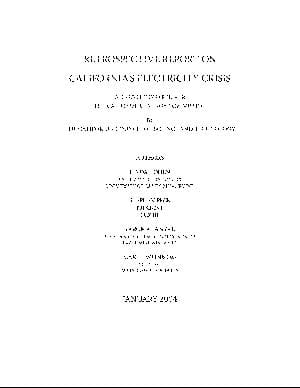Retrospective Report on California’s Electricity Crisis
Author(s): Cohen, Linda; Peck, Stephen; Sanyal, Paroma; Weinberg, Carl J.
Release Date: January 30, 2004 | Last Updated Date: January 30, 2004

Abstract
In 2000, severely limited energy supplies and extraordinarily high energy prices significantly impacted California. To better enable California’s policymakers to plan for the future, the California Energy Commission requested the California Council on Science and Technology to provide a detailed history of the energy crises, using objective data. The report was to include an overview of California’s energy situation, the role of the state and federal agencies, the impact of supply and demand on resources, the impact of deregulation, and lessons learned. The report was also to include chapters analyzing the resources, institutions, and regulatory controls that contributed to the problems in the supply of electricity.
Chapters in the report cover the evolution of federal electricity regulation and the process of restructuring in California. The supply and demand of electricity is reviewed. California electricity rate regulation, resource regulation and restructuring legislation is put in context with federal deregulation trends. Thee California “Crisis” is described in terms of the restructured electricity market. Price volatility and market manipulation were also factors contributing to the crisis. The current reforms and the roles of state agencies are then discussed. Finally, and most importantly, what are the lessons to take home from this experience?
Principal conclusions and recommendations:
The principal lessons learned from California’s experience with restructuring are:
- The lack of clear assignment of responsibility for planning and managing resource portfolios resulted in a failure to respond to early warning signals of supply/demand imbalance and reduced the ability to or proactive responses to manage risks associated with that imbalance.
- No entity had clear responsibility for market interaction action if system issues developed.
- Limited consideration was given to activities that markets do not do well, such as maintaining adequate generation reserve and gas storage capacities.
- Mechanisms for consideration and inclusion of rapid demand side response strategies were inadequate.
The shift in regulatory jurisdiction from the state to regional and federal levels create challenges for state policy. Nevertheless, it leaves the state with a range of tools to address state priorities in energy use:
- Retail rates remain regulated by the state and should be the focus of efforts to promote conservation.
- State influence on generation mix can derive from pollution tax policies or from state subsidy programs.
- State participation in the regional markets and regional infrastructure (transmission; water use) is increasingly important in the restructured environment.
Finally, it is clear that the introduction of markets does not remove state benefits from energy planning. Indeed, the reverse is the case: state energy use projections and plans, while considerably more difficult, are integral to accomplishing public goals.






